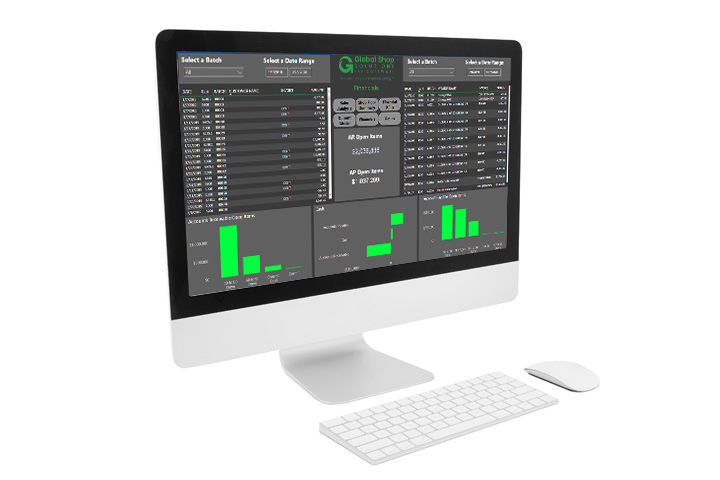Vice President of Operations and Service
- FMA
- The Fabricator
- FABTECH
- Canadian Metalworking
Categories
- Additive Manufacturing
- Aluminum Welding
- Arc Welding
- Assembly and Joining
- Automation and Robotics
- Bending and Forming
- Consumables
- Cutting and Weld Prep
- Electric Vehicles
- En Español
- Finishing
- Hydroforming
- Laser Cutting
- Laser Welding
- Machining
- Manufacturing Software
- Materials Handling
- Metals/Materials
- Oxyfuel Cutting
- Plasma Cutting
- Power Tools
- Punching and Other Holemaking
- Roll Forming
- Safety
- Sawing
- Shearing
- Shop Management
- Testing and Measuring
- Tube and Pipe Fabrication
- Tube and Pipe Production
- Waterjet Cutting
Industry Directory
Webcasts
Podcasts
FAB 40
Advertise
Subscribe
Account Login
Search
How stampers can upscale uptime with the Industrial Internet of Things
4 technologies that improve labor, machine performance for stamping manufacturers
- By Mike Melzer
- February 11, 2021
- Article
- Shop Management

The Industrial Internet of Things (IIoT) can help stamping manufacturers get the upper hand in their quest to improve labor and machine performance four ways. Getty Images
In the manufacturing world, few things impede production efficiency and profitability like labor activity and machine disruptions that go undetected or uncorrected on the shop floor. Manufacturers know this intuitively, yet many struggle to measure and manage performance accurately. Thanks to the Industrial Internet of Things (IIoT), stamping manufacturers are finally beginning to get the upper hand in their quest to improve labor and machine performance.
IIoT is the rapidly growing network of machinery and physical objects embedded with sensors, software, and other technologies that enable them to exchange information over the internet. As manufacturers begin to understand the capabilities and benefits of IIoT, more are employing four technologies to increase production by improving performance in the shop.
1. Display Real-time Data on the Shop Floor
Upscaling uptime starts with having readily accessible real-time data on the shop floor. When operators, technicians, toolmakers, and other personnel know what they should be working on now and what’s coming, they don’t waste time wondering what to do next.
Displaying data throughout your manufacturing facility requires mounting large TV screens or monitors, a low-cost and highly effective way of making vital production data available to supervisors and shop floor personnel.
These monitors link directly to the company’s enterprise resource planning (ERP) system. They display data that keeps personnel up to date on scheduling, work-in-progress (WIP), and other important production information – without having to log in to a computer, refer to manual spreadsheets, or hunt down a supervisor. Three types of data are especially relevant to upscaling uptime:
- Estimate Versus Actual. Monitors linked to your ERP can display the estimated performance compared to the actual performance matrix as soon as the technician logs off a job. This enables everyone to see whether the job is ahead, behind, or on schedule.
- Work Center Dispatch List. Displaying the dispatch list lets personnel know what they should be working on currently and what to work on next. If changes need to be made to the dispatch list, they can be communicated to the entire shop floor quickly and easily.
- Current WIP. This data provides a big-picture view of what’s happening on the shop floor at any given time. It displays who is working on what, when they started, and their estimated completion time.
When an individual employee or work center falls behind on a job, the TV or monitor displays red flags identifying the job is late, allowing supervisors to step in and take appropriate action. Employees can add notes that also will be displayed on the screen to help resolve the situation.

Stampers can use software interfaces to go paperless on the shop floor. These interfaces enable ERP systems to share information with third-party software applications used in the shop.
Displaying data throughout your facility is a simple process. Simply connect the wall-mounted screens to your ERP network, and they will import the selected data from HTML pages. Employees don’t have to log in to a computer to access the information, and the data can be automatically refreshed as often as necessary.
Displaying performance data throughout the shop not only reduces indirect time, it also makes workers more efficient, accountable, and proactive. A real-case example is of a manufacturer that pays bonuses based on part production goals. Displaying the estimated versus actual output data everywhere kept employees accountable and increased production by 20%.
2. Show Key Performance Indicators in Your Dashboard
While dashboards on the shop floor focus on what’s happening now and next, dashboards in your ERP system offer a broader and deeper range of data about the key performance indicators (KPIs) most important to your business. They also offer the flexibility and customization to see the data the way you need to see it, so you can capture the big picture as well as important details about your KPIs.
For example, suppose you run a part once a quarter, and the most recent estimate missed the mark by an uncomfortable margin. With a KPI dashboard, you can review the output of the last year or two with a few clicks of the mouse to determine whether the discrepancy was a random occurrence or a common event.
KPI dashboards can help answer important questions about performance, such as how each employee, machine, shift, and department is running. Where can we get better? Does an employee need more training, or is there a problem with the machine?
KPI dashboards also provide valuable information for employee reviews. Supervisors usually can tell the hard workers from the slackers, but KPI dashboards provide the data that makes it easy to determine whether the individual is entitled to a raise or needs coaching.
The dashboards come standard on most ERP systems, but their features and capabilities can vary widely. Upscaling uptime requires having the right data in an easily digestible format, which requires flexibility and customization.
3. Use Software Interfaces to Go Paperless on the Floor
Working with paper documents and manual data entry can make it hard to get data where it needs to go in a timely manner. Stampers can use software interfaces to go paperless on the shop floor. These interfaces enable ERP systems to share information with third-party software applications used in the shop. The primary goal is to reduce labor by eliminating the reliance on paper tracking.

Key performance indicators dashboards offer a broad and deep range of data about the most important aspects of your operation.
These interfaces allow engineers and technicians to digitally import drawings, spec sheets, bill of materials (BOMs), and other documents directly into the company’s ERP system so they have instant access to data needed for a job.
For example, a CAD interface can seamlessly integrate with leading design programs like SolidWorks, Solid Edge, and Autodesk Inventor. This interface enables the creation of large, complex BOMs. It also eliminates the errors that can occur with manual data entry.
Currently CAD, BOM, and nesting third-party applications are three of the most popular machine integrations.
With a CAD integration, stamping manufacturers can track engineering documents and any changes made to those documents on all machines across the shop floor. This keeps the machines running with the latest information, cuts down on scrap, and cuts out the manual process of updating the information on machines.
BOM integrations can instantly import volumes of BOM data, enabling engineers to build large, complex BOMs in a fraction of the time it would take to do it manually.
For those stampers using laser cutting machines, nesting integrations connect the software directly to a laser to optimize the layout. The software automatically designs and positions the part layout to minimize the amount of scrap after cutting is complete.
4. Use Machine Integration
Machine integration (MI) is rapidly becoming the next big thing in manufacturing. Computers are connected to machines, and machines are connected to each other to drive better performance and measure that performance in real time.
To increase productivity, MI connects a computer or laptop to a machine, such as a press. It tracks the press’s performance in real time and then sends the data directly to wall monitors mounted throughout the shop floor. While ERP systems can provide this data only after the job is complete, MI can measure and provide the data as it occurs.
For example, if you’re stamping 10,000 parts for a job, and 500 parts into production output starts falling behind, MI will alert you within minutes that production is lagging and send the data to the mounted monitors. From there supervisors can take steps to speed up the production process, thereby averting potential lost labor time and expense.
Implementing MIs can be costly, as it requires purchasing hardware and software. It can also require complex coding to put the data from different machines into the same format so it can be displayed on real-time dashboards. Nevertheless, the increase in labor efficiency and reduction of downtime can justify the cost.
IIoT: The Future of Manufacturing
Ultimately, upscaling uptime relies on the ability to effectively manage performance, which starts with making real-time data available to everyone where they work on the shop floor. Any time operators and technicians have to leave their workstations to log in to a computer or hunt down a supervisor to access data, performance decreases.
Displaying performance data on the shop floor does more than just reduce indirect time. Employees work more efficiently, and problems get solved quicker. Producing good estimates improves on-time delivery percentage. Accurate dispatching increases direct time. Your entire company operates more efficiently, allowing you to respond to changing customer needs faster and with more flexibility.
IIoT has already changed manufacturing in many ways, but it’s just getting started. As the technology continues to improve and machines get better at talking to each other, the stamping industry will change in ways that are hard to imagine. Using IIoT to upscale uptime is a great place to start.
About the Author
Mike Melzer
975 Evergreen Circle 77380
The Woodlands, TX 77380
Related Companies
subscribe now

The Fabricator is North America's leading magazine for the metal forming and fabricating industry. The magazine delivers the news, technical articles, and case histories that enable fabricators to do their jobs more efficiently. The Fabricator has served the industry since 1970.
start your free subscription- Stay connected from anywhere

Easily access valuable industry resources now with full access to the digital edition of The Fabricator.

Easily access valuable industry resources now with full access to the digital edition of The Welder.

Easily access valuable industry resources now with full access to the digital edition of The Tube and Pipe Journal.
- Podcasting
- Podcast:
- The Fabricator Podcast
- Published:
- 04/16/2024
- Running Time:
- 63:29
In this episode of The Fabricator Podcast, Caleb Chamberlain, co-founder and CEO of OSH Cut, discusses his company’s...
- Industry Events
16th Annual Safety Conference
- April 30 - May 1, 2024
- Elgin,
Pipe and Tube Conference
- May 21 - 22, 2024
- Omaha, NE
World-Class Roll Forming Workshop
- June 5 - 6, 2024
- Louisville, KY
Advanced Laser Application Workshop
- June 25 - 27, 2024
- Novi, MI































